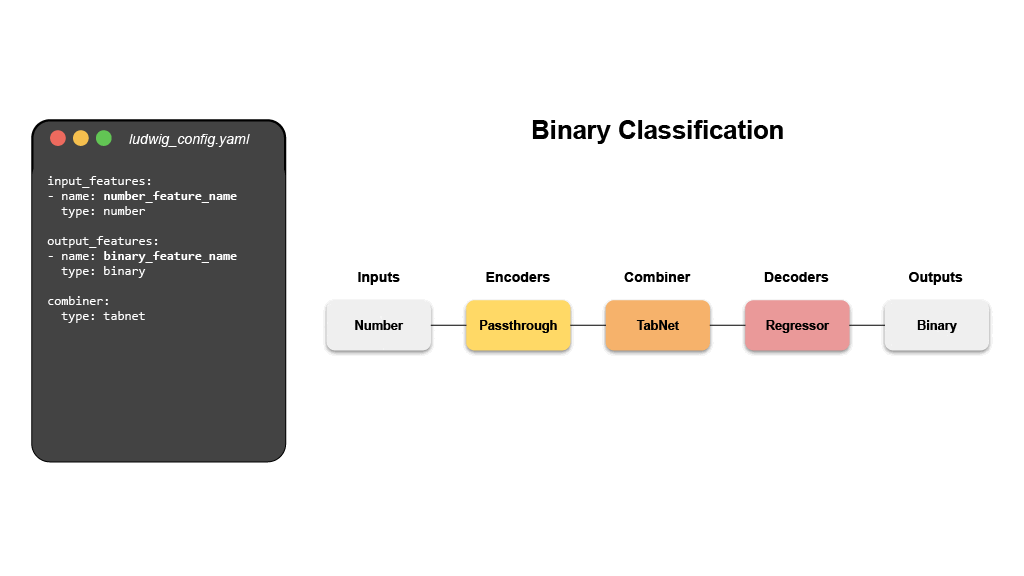
Ludwig
10.8k 1.2kWhat is Ludwig?
Ludwig is a low-code framework for building custom AI models like LLMs and other deep neural networks.
Ludwig Features
-
🛠 Build custom models with ease: a declarative YAML configuration file is all you need to train a state-of-the-art LLM on your data. Support for multi-task and multi-modality learning. Comprehensive config validation detects invalid parameter combinations and prevents runtime failures.
-
⚡ Optimized for scale and efficiency: automatic batch size selection, distributed training (DDP, DeepSpeed), parameter efficient fine-tuning (PEFT), 4-bit quantization (QLoRA), paged and 8-bit optimizers, and larger-than-memory datasets.
-
📐 Expert level control: retain full control of your models down to the activation functions. Support for hyperparameter optimization, explainability, and rich metric visualizations.
-
🧱 Modular and extensible: experiment with different model architectures, tasks, features, and modalities with just a few parameter changes in the config. Think building blocks for deep learning.
-
🚢 Engineered for production: prebuilt Docker containers, native support for running with Ray on Kubernetes, export models to Torchscript and Triton, upload to HuggingFace with one command.
Ludwig is hosted by the

💾 Installation
Install from PyPi. Be aware that Ludwig requires Python 3.8+.
pip install ludwigOr install with all optional dependencies:
pip install ludwig[full]Please see contributing for more detailed installation instructions.
🚂 Getting Started
Want to take a quick peak at some of the Ludwig 0.8 features? Check out this Colab Notebook 🚀 !Open In Colab
Looking to fine-tune Llama-2 or Mistral? Check out these notebooks:
-
Fine-Tune Llama-2-7b: !Open In Colab
-
Fine-Tune Llama-2-13b: !Open In Colab
-
Fine-Tune Mistral-7b: !Open In Colab
For a full tutorial, check out the official getting started guide, or take a look at end-to-end Examples.
Large Language Model Fine-Tuning
Let’s fine-tune a pretrained LLaMA-2-7b large language model to follow instructions like a chatbot (“instruction tuning”).
Prerequisites
-
Access approval to Llama2-7b-hf
-
GPU with at least 12 GiB of VRAM (in our tests, we used an Nvidia T4)
Running
We’ll use the Stanford Alpaca dataset, which will be formatted as a table-like file that looks like this:
| instruction | input | output |
|---|---|---|
| Give three tips for staying healthy. | 1. Eat a balanced diet and make sure to include… | |
| Arrange the items given below in the order to … | cake, me, eating | I eating cake. |
| Write an introductory paragraph about a famous… | Michelle Obama | Michelle Obama is an inspirational woman who r… |
| … | … | … |
Create a YAML config file named model.yaml with the following:
model_type: llm
base_model: meta-llama/Llama-2-7b-hf
quantization:
bits: 4
adapter:
type: lora
prompt:
template: |
Below is an instruction that describes a task, paired with an input that may provide further context.
Write a response that appropriately completes the request.
### Instruction:
{instruction}
### Input:
{input}
### Response:
input_features:
- name: prompt
type: text
output_features:
- name: output
type: text
trainer:
type: finetune
learning_rate: 0.0001
batch_size: 1
gradient_accumulation_steps: 16
epochs: 3
learning_rate_scheduler:
decay: cosine
warmup_fraction: 0.01
preprocessing:
sample_ratio: 0.1
backend:
type: localAnd now let’s train the model:
export HUGGING_FACE_HUB_TOKEN = "<api_token>"
ludwig train --config model.yaml --dataset "ludwig://alpaca"Supervised ML
Let’s build a neural network that predicts whether a given movie critic’s review on Rotten Tomatoes was positive or negative.
Our dataset will be a CSV file that looks like this:
| movie_title | content_rating | genres | runtime | top_critic | review_content | recommended |
|---|---|---|---|---|---|---|
| Deliver Us from Evil | R | Action & Adventure, Horror | 117.0 | TRUE | Director Scott Derrickson and his co-writer, Paul Harris Boardman, deliver a routine procedural with unremarkable frights. | 0 |
| Barbara | PG-13 | Art House & International, Drama | 105.0 | FALSE | Somehow, in this stirring narrative, Barbara manages to keep hold of her principles, and her humanity and courage, and battles to save a dissident teenage girl whose life the Communists are trying to destroy. | 1 |
| Horrible Bosses | R | Comedy | 98.0 | FALSE | These bosses cannot justify either murder or lasting comic memories, fatally compromising a farce that could have been great but ends up merely mediocre. | 0 |
| … | … | … | … | … | … | … |
Download a sample of the dataset from here.
wget https://ludwig.ai/latest/data/rotten_tomatoes.csvNext create a YAML config file named model.yaml with the following:
input_features:
- name: genres
type: set
preprocessing:
tokenizer: comma
- name: content_rating
type: category
- name: top_critic
type: binary
- name: runtime
type: number
- name: review_content
type: text
encoder:
type: embed
output_features:
- name: recommended
type: binaryThat’s it! Now let’s train the model:
ludwig train --config model.yaml --dataset rotten_tomatoes.csvHappy modeling
Try applying Ludwig to your data. Reach out
if you have any questions.
❓ Why you should use Ludwig
-
Minimal machine learning boilerplate
Ludwig takes care of the engineering complexity of machine learning out of
the box, enabling research scientists to focus on building models at the
highest level of abstraction. Data preprocessing, hyperparameter
optimization, device management, and distributed training for
torch.nn.Module models come completely free.
-
Easily build your benchmarks
Creating a state-of-the-art baseline and comparing it with a new model is a
simple config change.
-
Easily apply new architectures to multiple problems and datasets
Apply new models across the extensive set of tasks and datasets that Ludwig
supports. Ludwig includes a
full benchmarking toolkit accessible to
any user, for running experiments with multiple models across multiple
datasets with just a simple configuration.
-
Highly configurable data preprocessing, modeling, and metrics
Any and all aspects of the model architecture, training loop, hyperparameter
search, and backend infrastructure can be modified as additional fields in
the declarative configuration to customize the pipeline to meet your
requirements. For details on what can be configured, check out
docs.
-
Multi-modal, multi-task learning out-of-the-box
Mix and match tabular data, text, images, and even audio into complex model
configurations without writing code.
-
Rich model exporting and tracking
Automatically track all trials and metrics with tools like Tensorboard,
Comet ML, Weights & Biases, MLFlow, and Aim Stack.
-
Automatically scale training to multi-GPU, multi-node clusters
Go from training on your local machine to the cloud without code changes.
-
Low-code interface for state-of-the-art models, including pre-trained Huggingface Transformers
Ludwig also natively integrates with pre-trained models, such as the ones
available in Huggingface Transformers.
Users can choose from a vast collection of state-of-the-art pre-trained
PyTorch models to use without needing to write any code at all. For example,
training a BERT-based sentiment analysis model with Ludwig is as simple as:
ludwig train --dataset sst5 --config_str "{input_features: [{name: sentence, type: text, encoder: bert}], output_features: [{name: label, type: category}]}"-
Low-code interface for AutoML
allows users to obtain trained models by providing just a dataset, the
target column, and a time budget.
auto_train_results = ludwig.automl.auto_train(dataset=my_dataset_df, target=target_column_name, time_limit_s=7200)-
Easy productionisation
Ludwig makes it easy to serve deep learning models, including on GPUs.
Launch a REST API for your trained Ludwig model.
ludwig serve --model_path=/path/to/modelLudwig supports exporting models to efficient Torchscript bundles.
ludwig export_torchscript -–model_path=/path/to/model📚 Tutorials
🔬 Example Use Cases
💡 More Information
Read our publications on Ludwig, declarative ML, and Ludwig’s SoTA benchmarks.
Learn more about how Ludwig works, how to get started, and work through more examples.
If you are interested in contributing, have questions, comments, or thoughts to share, or if you just want to be in the
know, please consider joining the Ludwig Slack and follow us on Twitter!